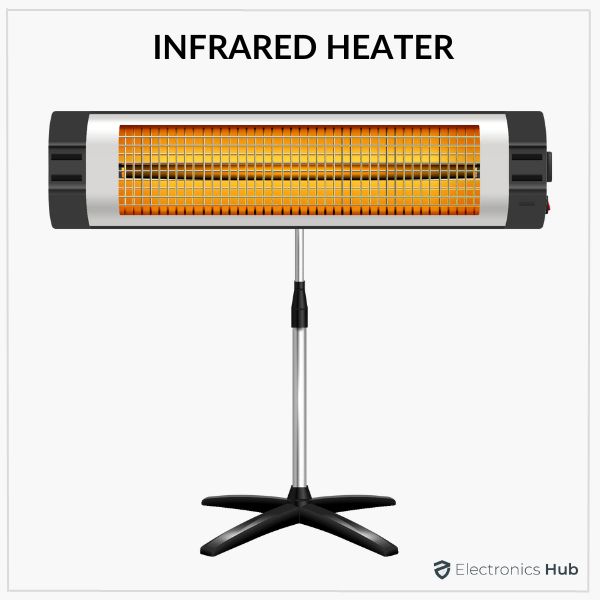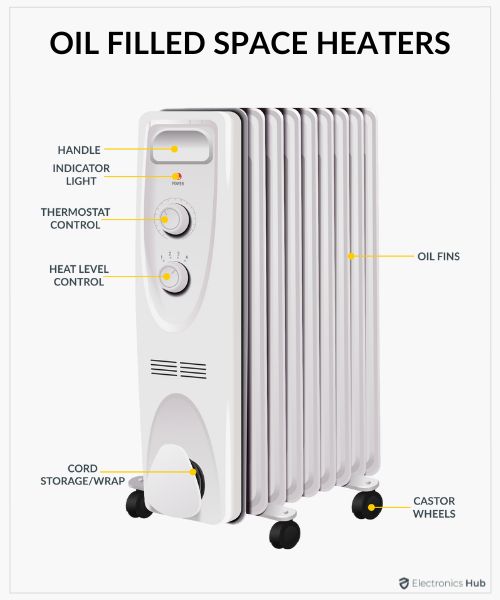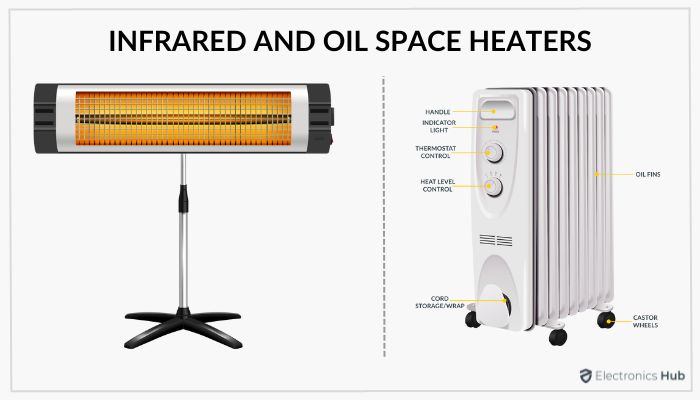With the shift away from burning fuels for environmental and efficiency reasons, electric heaters, particularly Infrared (Radiant) and Oil Heaters, stand out as popular choices.
This guide aims to provide a comprehensive comparison between Infrared and Oil Space Heaters, helping you make an informed decision based on their benefits and differences. As space heating is a significant energy consumer worldwide, understanding these options is crucial for selecting an efficient heater that meets your needs.
Outline
ToggleInfrared Heaters Overview

A typical Infrared Heater consists of a heating element and a reflector. The heating element is usually Tungsten or Nichrome Wire. When you pass electricity through the heating element, they become extremely hot and radiate thermal energy with the help of a reflector.
An interesting thing about Infrared Heaters is that they don’t heat the air in between. Other than electricity, we can also use natural gas or propane. But electric heaters are very common and popular.
Basic infrared heaters don’t come with fans. They use only the reflector to radiate the heat. But some models nowadays are coming with built-in fans that help in transferring the heat to a larger area and also even quicker.
If you choose infrared heaters with fans, then the air might become dry.
Advantages of Infrared Heaters
- They are quick and direct
- If you want heat instantly, then Infrared Heaters are a very good choice
- You can use them as spot heaters
- As they don’t use the air in between to transfer heat, the air doesn’t dry up
- Suitable for both indoor and outdoor usage
- Infrared Heaters are lightweight and easy to carry from room to room
- You can even get them as small portable models for on the go
- Quickly cools off when you turn them off
- They are very silent as they usually don’t come with fans
- As infrared heaters use electricity to produce heat, they do not emit any harmful gases. They are environmentally safe
Disadvantages of Infrared Heaters
- Cannot heat a large area. Only suitable for spot heating
- Safety hazard (due to the heating element)
- Less efficient than natural gas alternatives
Oil Space Heaters Overview:

Instead, we use electricity to heat the oil and transfer heat from the oil through convection. How does this work? If you look a typical Oil Space Heater, it has several fins (metallic radiators).
The oil usually sits at the base of the heater. When you turn the heater on, a heating element heats the oil. Once it is hot enough, the oil fills the fins evenly and transfers the heat to the surrounding air. We know that the density of hot air is less than that of cold air. So, the hot air near the Oil Heater moves up and pushes the cold air down.
Now, the cold air becomes hot due to the heat from the heater, and the process repeats until the entire room or space is hot (or warm). So, we are essentially using the oil to heat the surroundings and not as a fuel.
Most Oil Space heaters don’t use any fan similar to the Infrared Heater. The important thing in an Oil Space Heater is the oil itself. It is a diathermic oil (a combination of mineral oils) with high specific heat and thermal conductivity.
These properties help the oil in better transfer of heat to the surrounding air without cracking or oxidation.
Advantages of Oil Space Heaters
- Heats the entire room and not just a person or spot
- Compact and portable. Often, they come with wheels to easily move between rooms
- They run on electricity and do not use oil as fuel (instead they use it for convection)
- Energy efficient when you compare them with central heaters. They heat only the room you are in. If you want to heat multiple rooms, you can purchase more units. If an oil space heater has an automatic system, then it can turn itself off to save electricity
- No fans or moving parts. Very silent operation
- Even though we heat the oil, it doesn’t evaporate for a very long time. You don’t have to worry about refilling
- They can retain heat for a long time even after we turn off the heater
- No need for any maintenance or servicing
- Comes with analog or digital thermostat controls. Some models even come with remote controls
- As there is no exposed heating element, they are very safe to use
Disadvantages of Oil Space Heaters
- Even though oil space heaters have very good heat transfer properties, they are not suitable for quick heating. They take some time to heat the room
- Slightly more expensive than simple infrared heaters
- They are bulky devices. Even though they come with wheels, you need to put significant effort to move it
Differences Between Infrared and Oil Space Heaters

1. Overall Design (Size, Weight, and Portability)
Electric Infrared Heaters are small, compact, and lightweight devices. They don’t need any wheel as you can simply carry them using your hands from one room to other. Most units come with handles or cutouts to easily carry them.
Oil Space Heaters are compact devices but they are big and bulky. Smaller models with a heating power of 700W do not usually come with wheels but most of them have carry handles.
Larger 1,500W Oil Heaters usually come with wheels so that you can easily drag them between rooms. Regardless of whether wheels are present or not, you need to put some effort to move Oil Space Heaters.
2. Heating Speed
Infrared Heaters are famous for their quick heating feature. It will take less than a minute for the heater to radiate heat. When you turn off the heater, the heating element cools down quickly and it doesn’t retain the heat.
So, if you want to use the heater for a long time, you have to keep it on continuously. This means your electricity bill will be very high.
Oil Space Heaters are relatively slow. First, the heating element starts heating the oil. As the oil reaches the optimal temperature, it floats in the radiator fins. Then through convection, it heats the air surrounding it. For the complete room to become warm, it takes a significant amount of time.
But the advantage of Oil Space Heaters is they are very good at retaining the heat even after you turn the heater off. So, when you set a temperature, the thermostat starts the heater and when it reaches the desired temperature, it turns off the heater to save electricity.
3. Heating Capacity & Heat Distribution
Continuing heating-related discussion, the heating capacity of an Infrared Heater is very low. Also, the distribution of heat is very focused, usually confined to a spot in front of the heater. Do not expect it to heat an entire room.
In this regard, the Oil Space Heaters are much better. First of all, the Oil Heater heats the air in the room. Even though it is slow, the entire room becomes warm. Also, it distributes heat very evenly.
4. Efficiency
Infrared Heaters are efficient if you want heating for one or two persons and not the entire room. But when you compare electric infrared heaters with other types such as natural gas infrared heaters, they are less efficient.
As Oil Heaters distribute heat evenly, they can make the entire room warm. So, if your requirement is to heat a medium to a large room, then Oil Space Heaters are very efficient.
5. Comfort
As Infrared Heating is direct and focused, you can feel the heat on your skin as you would feel the heat from the sun. even though Infrared Heater doesn’t heat the surrounding air, the direct heating nature can make your skin dry.
In contrast, Oil Space Heaters heat the surrounding air through convection. This might make the air feel dry. Some might feel this comfortable while others don’t like the dry air. So, the concept of comfort is highly subjective.
6. Storage
Due to its size and weight, you can carry the infrared heater anywhere you want and store it during summer. It doesn’t need a huge amount of space.
Oils Heaters are big and bulky devices. So, while you are packing it for summer, you need to look for a decent space in the garage or store room.
7. Overnight Use & Safety
Both infrared heaters and oil space heaters are suitable for overnight usage. However, the red and hot heating element of the infrared heater might be distracting. Also, you have to be careful with kids and pets around the infrared heaters due to their exposed heating element.
Oil Space Heaters are very safe for overnight use without any restrictions. They are also very safe for kids and pets as the heating element is deep inside the heater and the radiator fins are also cool to the touch.
In either case, you can use the heater overnight only when you are present in the room.
There are several safety features in both infrared heaters and oil heaters such as auto shutoff, overheat protection (thermal switch), tip-over protection (for oil space heater), etc.
8. Plug-and-Play & Remote Control
Infrared Heaters and Oil Heaters are simply plug-and-play devices. You don’t need to set up or adjust any settings. While basic models come with onboard controls (analog or digital), some advanced models come with remote controls.
9. Maintenance
There is absolutely no need for maintenance in the case of both heaters. There are no moving parts but some infrared heaters are coming with a fan to spread the heat even further. In such devices, you have to clean the fans once in a while.
Even though there is oil in the Oil Space Heater, we are not consuming it as fuel and it is a non-consumable part. So, you don’t have to worry about replacing or refilling oil. The tight seal of the heater ensures that the oil doesn’t leak out.
If you have any problem with the infrared heater (loose wiring or no connection), you can attempt to fix it if you have the necessary knowledge and skill. This is not the case with oil space heaters. It is much more complex in this aspect.
In either case, we recommend you consult a trained electrician or repair personnel to fix the heater.
10. Durability & Stability
The lightweight and small size of the infrared heater makes it less stable and durable. So, be careful when using it and try not to make it fall and it might damage easily.
Oil Space Heaters are made from metal for both body and radiators. Even if the front portion of the heater is made out of plastic, the long design and sturdy build make it durable and stable.
11. Cost
Both infrared heaters and oil space heaters are available in a similar price range. Ut for watt-to-watt comparison, oil heaters are slightly more affordable than infrared heaters.
You can get a decent 1,500-Watt Oil Heater for $70 to $90. But for the same heating, you need to spend more than $130 for an infrared heater.
12. Power Usage
Infrared heaters emit radiation to directly warm objects and people, offering quick heat without warming the air, typically consuming between 300W to 1500W. They are efficient for targeted heating.
Oil space heaters heat oil internally, then radiate warmth into the room via convection, slowly but effectively distributing heat. Their power usage of oil space heaters also ranges from 700W to 1500W, efficient for prolonged heating and retaining heat longer.
Comparison: Infrared vs Oil Space Heater
The following table provides a simple side-by-side comparison of Infrared vs Oil Space Heaters for easy understanding.
| Parameter | Infrared Heater | Oil Space Heater |
| Size | Small | Slightly big |
| Weight | Lightweight | Heavy |
| Design | Small and compact. You can choose from several designs and styles. | Compact but bulky. All models look like generic space heaters. |
| Portability | Very portable. Easily carry it with a hand from one room to other. | Even though it is heavy, you can move it between the room using the wheels. |
| Location | You can use it both indoors and outdoors. Very versatile. | Only for indoor usage. |
| Storage | Very easy to store anywhere you want. | Due to its size, it occupies slightly more space. So, suitable for small storage rooms. |
| Heating Speed | Very fast. Almost instant heating. | Slow. Takes several minutes before reaching good temperature. |
| Heat Recovery | Fast | Slow |
| Efficiency | Not that efficient when compared to other heating systems. | Very efficient. |
| Heat Distribution | Spot heating only. Ideal for people who are directly in front of the unit. | Very even heat distribution. Even though it is slow, it heats the entire room. |
| Heating Capacity | Low. Only for people in front of the heater. | Large. Can heat medium to large room. |
| Comfort | Generally comfortable. But it feels like heat from the sun. | As it heats the air in the room, you feel more comfortable. |
| Overnight Use | You can use it. But light from the heating element may be distracting. | No visible heating element. You can use them overnight. Generally, with any heater, use it overnight only if you are in the room. |
| Plug-and-Play | Yes | Yes |
| Remote Control | Yes | Yes |
| Maintenance | No maintenance | No maintenance |
| Noise | Quite | Quite |
| Durability | Not highly durable | Very durable |
| Stability | Lightweight and delicate. Not a very stable unit. | Built with metal and filled with oil. Very stable. |
| Mount Style | Use it however you like. Wall, ceiling, floor, table. | Usually, it is floor standing only. |
| Safety | The heating element is clearly visible and accessible. Must be very careful with children or pets near it. | The heating element is not visible. Also, the surface of the radiator is cool to the touch. It is a very safe heater. |
| Cost | Available in a wide price range. Between $35 to $200 or more. | Similar price range. |
| Power Usage | Consume between 300W to 1500W. | Consume between 700W to 1500W. |
Where Can You Use It? What is The Mount Style?
Infrared Heaters are very versatile devices. You can use them both indoors and outdoors as they radiate the heat to a spot and do not heat the surrounding air.
Coming to mounting, here also infrared heaters are very versatile. You can use them on the floor, mount them to walls or ceilings, use them on a table, etc.
Oil Space Heaters are strictly floor-standing devices. Also, they are designed for indoor use only. The reason is they heat the air in the room. So, if you use them outside, you are essentially wasting energy as there will always be cold air in the vicinity.
Which One to Buy, an Infrared or Oil Space Heater?
There are multiple factors that affect deciding whether an infrared heater is better or an oil heater is better. If you are looking to provide heat for one or two persons with direct heat, then Infrared Heaters are a simple and elegant choice.
But if you want to heat the room, then Oil Space Heaters can do a very good job. While both these heaters are suitable for indoor usage, the infrared heater has the advantage of using outdoors.
We have seen several other differences between Infrared and Oil Space Heaters. So, it boils down to your requirement, the area/space you are trying to heat, and cost among other things.
Conclusion
Infrared Heaters and Oil Heaters are two popular types of space heaters for small rooms. If you don’t have a central heating system and are looking for a decent room heater, then these two options will pop up at the top.
In this guide, we saw the basics of Infrared Heaters as well as Oil Heaters and how they work. We also saw their pros and cons.
After that, we looked at the differences between Infrared and Oil Space Heaters. For an easy understanding, we made a simple side-by-side comparison of Infrared vs Oil Space Heaters.
If you feel we missed something or want us to add anything, do let us know in the comments section. It will not only help us but also other readers.

